france
new! Cathedrale Saint-Gatien at Tours 
 updated: Romanesque churches and cathedrals in south-west France updated: Romanesque churches and cathedrals in south-west France
the perpendicular or English style of cathedral 
the fire at the cathedral of Notre-Dame de Paris

cathedral giants - Amiens and Beauvais
Stone tracery in church and
cathedral construction 
stone in church and cathedral construction stained glass and cathedrals in Normandy  
fortified churches, mostly in Les Landes
cathedral labyrinths and mazes in France
using metal in gothic cathedral construction
Germans in France
cathedral destruction during the French revolution, subsidiary page to Germans in France

on first arriving in France - driving
France is not England
paying at the péage (toll station)

Transbordeur bridges in France and the world 2: focus on Portugalete, Chicago,
Rochefort-Martrou
Gustave Eiffel’s first work: the Eiffel passerelle, Bordeaux
a fifth bridge coming to Bordeaux: pont Chaban-Delmas, a new vertical lift bridge
France’s western isles: Ile de Ré
France’s western iles: Ile d’Oleron
Ile de France, Paris: in the context of Abelard and of French cathedrals
short biography of Pierre (Peter) Abelard
Marianne - a French national symbol, with French definitive stamps
la Belle Epoque
Grand Palais, Paris


Pic du Midi - observing stars clearly, A64
Carcassonne, A61: world heritage fortified city
Futuroscope
Vulcania
Space City, Toulouse
the French umbrella & Aurillac
50 years old:
Citroën DS
the Citroën 2CV:
a French motoring icon
the forest as seen by Francois Mauriac, and today
Les Landes, places and playtime
roundabout art of Les Landes
Hermès scarves

bastide towns
mardi gras! carnival in Basque country
country life in France: the poultry fair
what a hair cut! m & french pop/rock

Le Tour de France: cycling tactics 

advertising disclaimer |
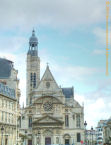 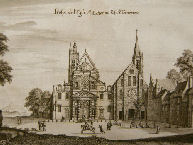 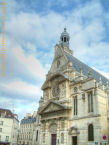  |
| Click on a
thumbnail to jump to a bigger version of each image
with description |
 |
![Map of part of modern Paris [fom Google] Map of part of modern Paris [fom Google]](images/google_map_tnl.png) |
 |
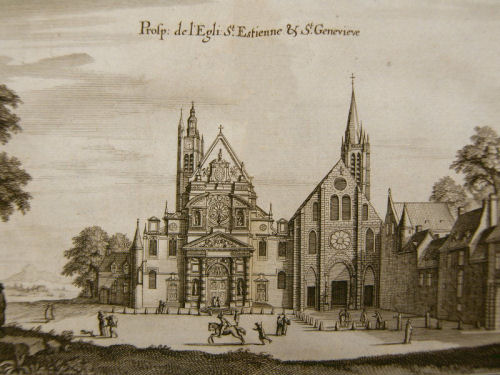
Churches in Paris of Saint-Étienne-du-Mont
[the more elaborate building on the left]
and the church of Sainte-Geneviève abbey [the more
austere building to the right, which no longer exists]
“Prosp. de l'Egli. St. Estienne & St. Genevieve”
A copper engraving by Matthaeus
Merian, printed at Frankfurt am Main, about 1655
[Part of the Topographia Galliae, Oder Beschreibung
und Contrafaitung.]
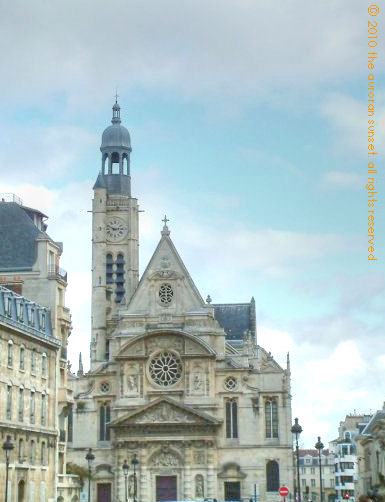
A recent photograph of Saint-Étienne-du-Mont Church,
Paris as shown
in the 17th century engraving above. Traffic pollution filth has been trapped
under the porticos and ledges, darkening them badly.
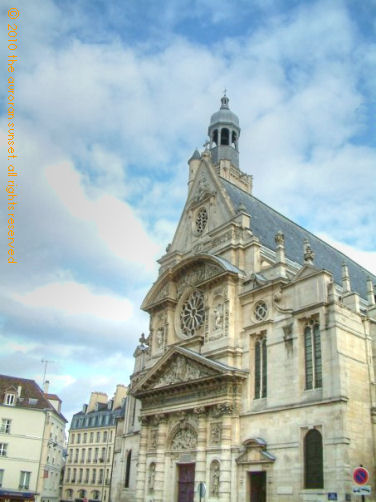
A recent photograph of Saint-Étienne-du-Mont Church,
Paris -
a more artistic view
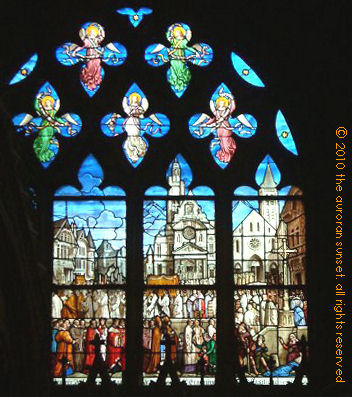
Stained glass window inside Saint-Étienne-du-Mont
Church, Paris
showing the two churches in the 17th
century copper engraving
The School of Sainte Geneviève, together with the
Cathedral School and the school of St. Germain des Pré,
were the forerunners of what in the following centuries
become the Paris University schools. The School of Sainte
Geneviève housed a library, which is now part of
the Sorbonne Library.
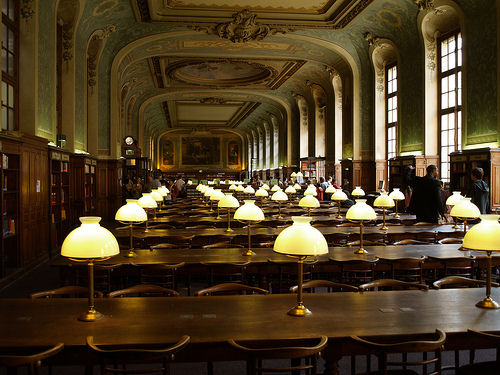
Reading room of the Sorbonne Library.
Image: abac077
Abelard
working at Ste Geneviève
When he came to Paris, Abelard hoped to become a master
at the Notre Dame Cathedral School. This position was
not forthcoming, so in 1108 Abelard set up a school at
Mont-Ste.-Genevieve, just outside the city walls, on the
site of the present University of Paris. In 1113, Abelard
finally took up the chair at the Cathedral School. At
both these schools, he became a renowned teacher of dialectic
and rhetoric, attracting many students.
Where Abelard taught in the paris
region
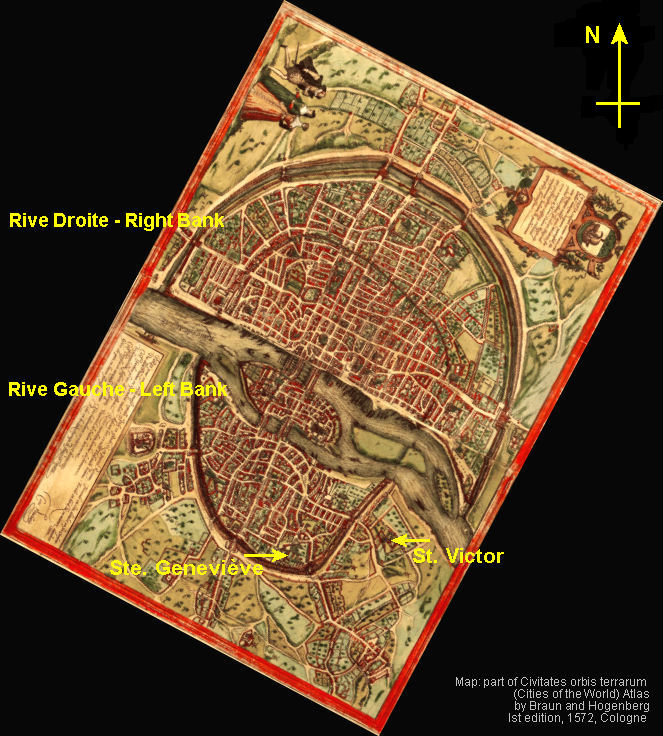
This map dates from 1572, and so from considerably later
than the time when Pierre Abelard was strutting his stuff.
By that time, Paris was already growing like an octopus.
[On rive gauche and rive
droite.]

Here is
a description of Paris at the time of Abelard, about 450
years earlier.
“If you desire to see the Paris of those early
days, imagine yourself beside the spot where the modern
Pantheon stands.
“It is the summit of what Paris called ‘the
hill’ for many a century—the hill of St.
Genevieve. Save for the large monastery of secular canons
beside you, the abbey of St. Genevieve, there is yet
little sign of the flood of grimy masonry that will
creep up slowly from the river valley, as the ages advance,
and foul the sweet country for miles beyond. Paris lies
down in .the valley below, a toy city. The larger island
in the Seine bears almost the whole weight of the capital
of France. It has, it is true, eaten a little way into
the northern bank of the river, to which it is joined
by the Great Bridge[2]. That is
the Lombard Quarter, and Lutetian commerce is increasing
rapidly. Numbers of curious ships sail up the broad,
silver bosom of the Seine and make for the port of St.
Landry. The commercial quarter is already spreading
in the direction of Montmartre, with the public butchery
and bakery at its outskirt; but it is a mere fringe.
The broad valleys and the gentle hills that are one
day to support Paris are now clothed with vineyards
and orchards and cornfields, and crowned with groves
of olive[3] and oak. On the nearer
side, too, the city has already overflowed the narrow
limits of the island. There are houses Oft the fine
stone bridge, the Little Bridge, and there is a pretty
confusion of houses, chapels, schools, and taverns gradually
stealing up the slope of St. Genevieve. But, here also;
most of the hill is covered with gardens and vineyards,
from which a chapel or a relic of old Roman Lutetia.
peeps out here and there—the ruins of the famous
old thermæ lie halfway down the hill below us—;
and along the valley of the
‘… florentibus ripis amnis’[4]
“(to quote a poet of the time). to east and
west, are broad lakes of fresh green colour, broken
only in their sweet monotony by an occasional island
of masonry, an abbey with a duster of cottages about
it.
“It is down straight below us, on the long,
narrow island, that we see the heart of France, the
centre of its political, intellectual, and ecclesiastical
life. A broad, unpaved road, running from Great Bridge
to Little Bridge, cuts it into two. Church occupies
most of the eastern half, State most of the western;
their grateful subjects pack themselves as comfortably
as they can in the narrow fringe that is left between
the royal and ecclesiastical domains and the bed of
the river. Each generation in turn has wondered why
it was so scourged by ‘the burning fire’’
(the plague), and resolved to be more generous to the
Church. From the summit of St. Genevieve we see the
front of the huge, grey, Roman cathedral, that goes
back to the days of Childebert. and residences of its
prelates and canons bordering the cloister. Over against
it, to the west; is the spacious royal garden, which
is graciously thrown open to the people two or three
times a week, with the palace of King Philip at the
extremity of the island. That is Paris in the year of
grace 1100; and all outside those narrow limits is a
very dream of undulating scenery, with the vesture of
the vine, the fir, the cypress, the oak, the olive,
and the fig; and the colour of the rose, the almond,
the lily, and the violet; and the broad, sweet Seine
meandering through it; and the purest air that mortal
could desire
“To our young philosopher Paris probably presented
itself first in the character of ‘the city of
philosophers.’ Each of the great abbeys had its
school. That of the abbey of St. Genevieve will soon
be familiar to us. The abbey of St. Germain of Auxerre,
to the north, and the abbey of St. Germain of the Meadow»
to the west, had schools at their gates for all comers.
St. Martin in the Fields had its school, and the little
priory of St. Victor, to the east, was soon to have
one of the most famous of all schools of theology. The
royal abbey of St. Denis, a few miles away, had a school
in which Prince Louis was then being trained, together
with the illustrious Abbot Suger. A number of private
schools were scattered about the foot of St. Genevieve.
The Jews had a school, and-mark the liberality of the
time-there was. or had been until a very few years before,
a school for women; it was conducted by the wife and
daughters of famous Master Manegold, of Alsace, women
who were well versed in Scripture, and ‘most distinguished
in philoophy,’says Muratori.
“But Abélard went straight to the centre
of Paris, to the cloistral enclosure under the shadow
of old Notre Dame,[5] where
was the first episcopal school in the kingdom, and one
of the first masters in Christendom. William of Champeaux
was a comparatively young master, who had forced his
way into high places by sheer ability. He was held to
be the first dialectician in France, and ‘almost
the first royal councilor.’ In the great philosophic
controversy of the period he was the leader of the orthodox
school. The Bishop of Paris had brought him to the island-city,
and vested him with the dignity of arch-deacon of the
cathedral and scholasticus (chancellor or rector) and
master of the episcopal school. So high was the repute
of his ability and his doctrine that, so Fleury says,
he was called ‘the pillar of doctors.’ From
an obscure local centre of instruction he had lifted
the Parisian school into a commanding position, and
had attracted scholars from many lands. ...” [6]
[Quoted from Peter Abélard by Joseph
McCabe, 1901, pp. 18 - 22]
end
notes
- Matthaeus Merian
(1593-1650) was a notable Swiss engraver. With Martin
Zeiler (1589-1661), a German geographer, and later (about
1640) with his own son, Matthäus Merian Jr. (1621-1687),
he produced a series of Topographia consisting of 21
volumes, collectively known as the Topographia
Germaniae. After Merian’s death, the businss
was continued by his sons Matthäus Jr.and Caspar
Merian (1627-1686) under the name Merian Erben.
- The Grand Pont [Great Bridge] is now called Pont Notre Dame.
- “This and other
details I gather from fragments of the minor poets of
the time. ”
- ... prosperous banks
of the river...
- The Notre
Dame of to-day, like the earlier Louvre, dates from
the end of the twelfth century.
- From Chapter 2 of Peter Abélard by Joseph McCabe,
Duckworth, London, 1901.
- La Rive Gauche - the Left Bank - and la
Rive Droite - the Right Bank - refer to the banks
of the River Seine as it flows through Paris on its
way to La Manche - the English Channel. Thus
the southern part of Paris, with the 5th, 6th, 7th,
13th, 14th, 15th arrondissements, are on the Rive
Gauche. Since the early twentieth century, the Rive Gauche has been associated with an artistic
and bohemian way of life. On the other hand, the Rive
Droite and its districts such as the
16th and 17th arrondissements, is linked more conventional,
bourgeois, conservative attitudes.
|
















